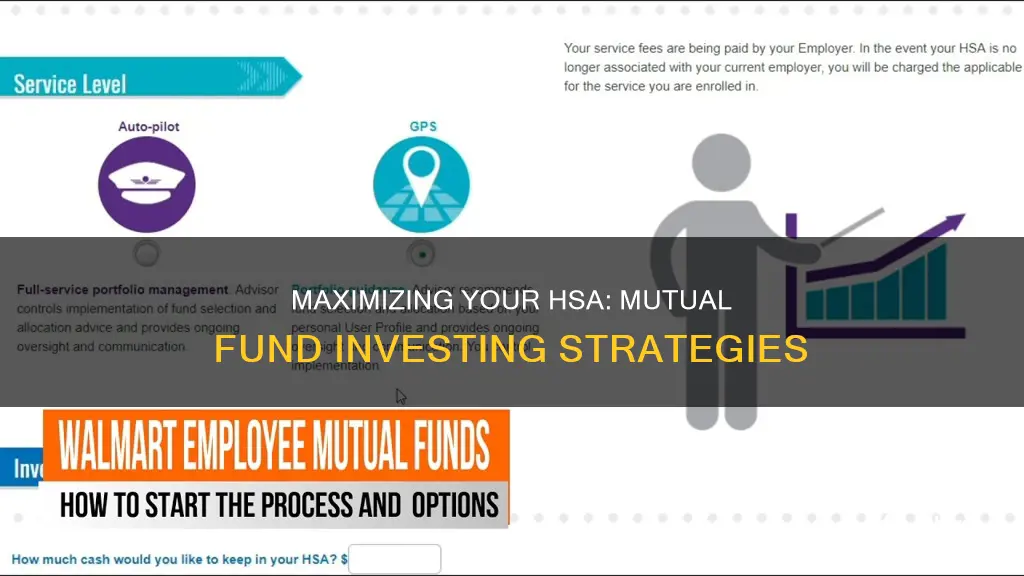
Health Savings Accounts (HSAs) are a great way to save for future medical expenses or boost your retirement funds. HSAs are available to those with a high-deductible health insurance plan, and they help pay for out-of-pocket medical expenses. HSAs offer a triple tax benefit: contributions are tax-deductible, earnings are tax-free, and withdrawals are tax-free when used for qualified medical expenses. You can invest HSA funds in a variety of ways, including stocks, bonds, mutual funds, and ETFs. Investing your HSA funds can help you grow your savings tax-free, but it's important to consider your unique circumstances, risk tolerance, and potential future medical needs when deciding how to invest.
| Characteristics | Values |
|---|---|
| Tax on investment gains | Not taxed |
| Minimum required to open an account | $0 |
| Access to funds | Anytime |
| Investment options | Robo advisor, DIY investing |
| Individual health plan contribution limit | $4,150 |
| Family health plan contribution limit | $8,300 |
| Additional contribution limit for those 55+ | $1,000 |
| Investment options | Stocks, bonds, ETFs, mutual funds, etc. |
| Investment tools | Automatic or manual investment options |
What You'll Learn

HSA funds can be used to invest in stocks
A Health Savings Account (HSA) is a tax-efficient way to save for future medical expenses. HSAs are available to those with a high-deductible health insurance plan, and they help pay for out-of-pocket medical expenses. HSAs offer a triple tax benefit: contributions are tax-deductible, earnings are tax-free, and withdrawals are tax-free when used for qualified medical expenses.
You can invest your HSA funds in stocks to make your money grow faster. Investing in stocks can be done through individual stocks or stock-based funds such as index funds and dividend funds. Index funds offer a diversified group of stocks that track indexes like the S&P 500 or Russell 2000, while dividend funds focus on stocks that pay dividends, which are typically established companies with a proven business model.
When investing in stocks with your HSA, it's important to consider your risk tolerance and potential future medical needs. If you're using your HSA primarily as a retirement account, you may opt for high-return investments. However, if you need access to the funds in the near term, it's crucial to maintain liquidity by investing in lower-risk options or keeping a portion of your HSA in cash.
Before investing your HSA funds, ensure you understand the investment options available to you, as the choices may vary depending on your HSA provider. Additionally, some HSA providers require you to maintain a minimum cash balance before you can start investing. By investing your HSA funds in stocks, you can take advantage of the account's tax benefits while potentially growing your savings for future medical or retirement expenses.
Best Funds to Invest in Right Now
You may want to see also

HSA funds can be used to invest in mutual funds
A health savings account (HSA) is a great way to save for future medical expenses and comes with a triple tax benefit. Contributions to HSAs are tax-deductible, with individuals able to contribute $4,150 in 2024 and families able to put in $8,300. Those aged 55 and older can contribute an additional $1,000 as a catch-up contribution. Any earnings on the account remain tax-free as long as the money is used for qualified medical expenses, and the money can be withdrawn tax-free at any time to pay for these expenses.
You can invest a portion of your HSA in a wide variety of mutual funds to give your account the potential to grow over time. Any earnings on investments in your HSA are federally tax-free. Some people keep enough in their cash account to cover current expenses and invest the remainder of their funds to take advantage of the potential growth opportunity to help build their account for when they may need it in the future, including retirement.
There are two options to set up investments. The first is to let the system automatically transfer funds into and out of your investment account to maintain the cash balance you want to keep in your account, also known as the investment threshold. The second option is to manually manage each transaction between your cash and investment accounts whenever you want, giving you more control over your investment transactions.
Before you can begin investing, you must first reach a minimum balance in your cash account. This minimum balance will depend on your HSA provider.
Investing your money through an HSA will likely allow it to grow faster than by saving alone. However, if your HSA is offered through an employer, you may have fewer options for how you can invest your money.
Short-Term Investment Strategies: Where to Invest Your Money
You may want to see also

HSA funds can be used to invest in ETFs
A health savings account (HSA) is a tax-efficient way to save for future health-related expenses. HSAs are available to those with a high-deductible health insurance plan, and they help pay for out-of-pocket medical expenses. HSAs offer a triple tax benefit: contributions are tax-deductible, growth is tax-free, and withdrawals are tax-free when used for qualified medical expenses.
You can invest HSA dollars just like you would with an individual retirement account (IRA). You can choose from a variety of investment options, including stocks, bonds, mutual funds, and ETFs. Investing your HSA dollars can help your savings grow faster than simply saving alone.
- Understand your risk tolerance and potential future medical needs. If you have a low-risk tolerance or anticipate needing money for medical expenses in the near term, consider investing in more conservative options like short-term bond funds or money market funds.
- If you have a higher-risk tolerance and don't expect significant medical expenses in the coming years, investing in stocks or stock-based ETFs can be a good option. Index funds, dividend funds, and individual stocks are all possibilities.
- Consider the fees associated with different ETF options. Look for low-cost, diversified investments to keep more of your investment returns.
- Evaluate your time horizon. If you're investing for the long term, you may be able to withstand more volatility and target higher returns. If you need the money sooner, you may want to choose more conservative investments.
- Some HSA providers offer tools to help you choose your investments and provide automatic rebalancing to maintain your preferred allocation.
- If your HSA is offered through an employer, you may have more limited investment options.
Key Considerations for Investing in Algorithmic Trading Funds
You may want to see also

HSA funds can be used to invest in bonds
A health savings account (HSA) is a tax-efficient way to save for future health-related expenses. HSAs are available to those with a high-deductible health insurance plan, and they help pay for out-of-pocket medical expenses. HSAs offer a triple tax benefit: contributions are tax-deductible, investment growth is tax-deferred, and withdrawals are tax-free when used for qualified medical expenses.
You can invest HSA funds in the same way you would an individual retirement account (IRA) or other investment accounts, such as stocks, bonds, mutual funds, and ETFs. Investing HSA funds is a great way to take advantage of the account's benefits and grow your savings. Some HSAs offer tools to help you choose your investments and provide automatic rebalancing, while others allow you to select specific investments.
When determining how to invest your HSA funds, consider your unique circumstances, risk tolerance, and potential future medical needs. If you're using your HSA primarily as a retirement account, you may opt for high-return investments. However, if you have a lower risk tolerance or expect future medical expenses, you may want to focus on more conservative investments, such as short-term bond funds.
- Fidelity Short-Term Bond Fund (FSHBX)
- Schwab Value Advantage Money Fund - Investor Shares (SWVXX)
KiwiSaver Investment Funds: Where Does Your Money Go?
You may want to see also

HSA funds can be used to invest in dividend-paying stocks
Health savings accounts (HSAs) are a great way to save for future medical expenses or boost your retirement funds. HSAs are available to those with a high-deductible health plan and help pay for out-of-pocket medical expenses. The money in an HSA can be invested in various ways, including dividend-paying stocks, to grow your funds tax-free.
Investing HSA funds in dividend-paying stocks is a good option for those looking for a more targeted approach. Dividend-paying stocks are typically offered by profitable and established companies, making them potentially safer investments than those of younger companies without a proven business model. Dividend funds also provide the benefit of tax-free dividends, which can be reinvested or held as cash in your HSA account.
When investing HSA funds, it is important to consider your unique circumstances, including your risk tolerance and potential future medical needs. If you are using your HSA primarily as a retirement account, you may opt for high-return investments. However, if you plan to regularly tap into your HSA, low-risk and low-return options, such as money market funds, may be more suitable.
By investing HSA funds in dividend-paying stocks, you can take advantage of the tax benefits associated with HSAs while potentially growing your savings over time. This strategy can be a powerful tool for accumulating wealth and preparing for future medical or retirement expenses.
Arbitrage Funds: Strategic Investment Opportunities for Savvy Investors
You may want to see also
Frequently asked questions
A health savings account (HSA) is available if you have a high-deductible health insurance plan, and it helps pay for out-of-pocket medical expenses.
Investing in an HSA can help you prepare for future medical expenses. One of the biggest benefits is the triple tax advantage, where contributions are tax-deductible, growth is tax-free, and distributions are tax-free when used for qualified medical expenses.
You can invest a portion of your HSA in a wide variety of mutual funds. Some people keep enough in their cash account to cover current expenses and invest the remainder of their funds to take advantage of potential growth opportunities.







